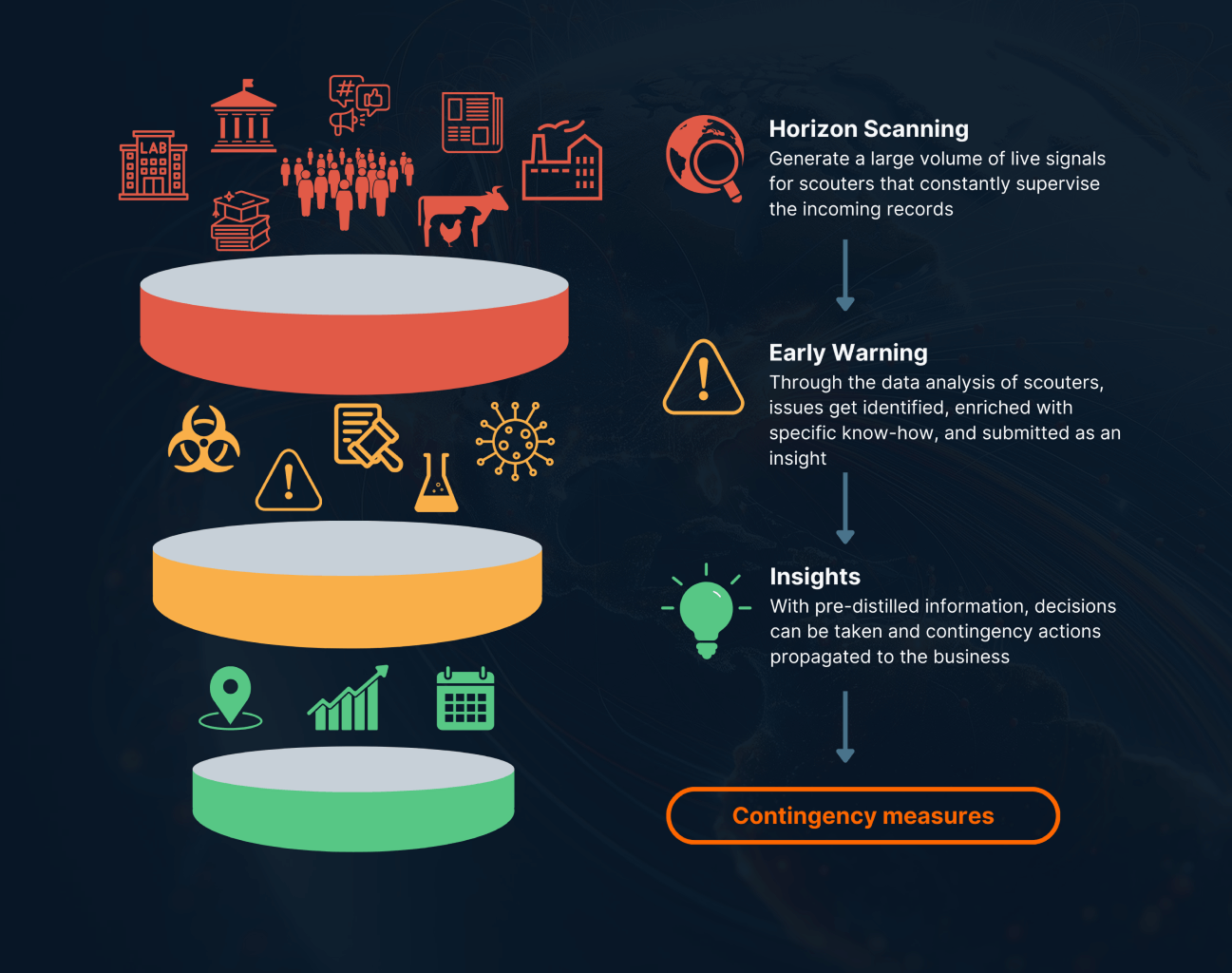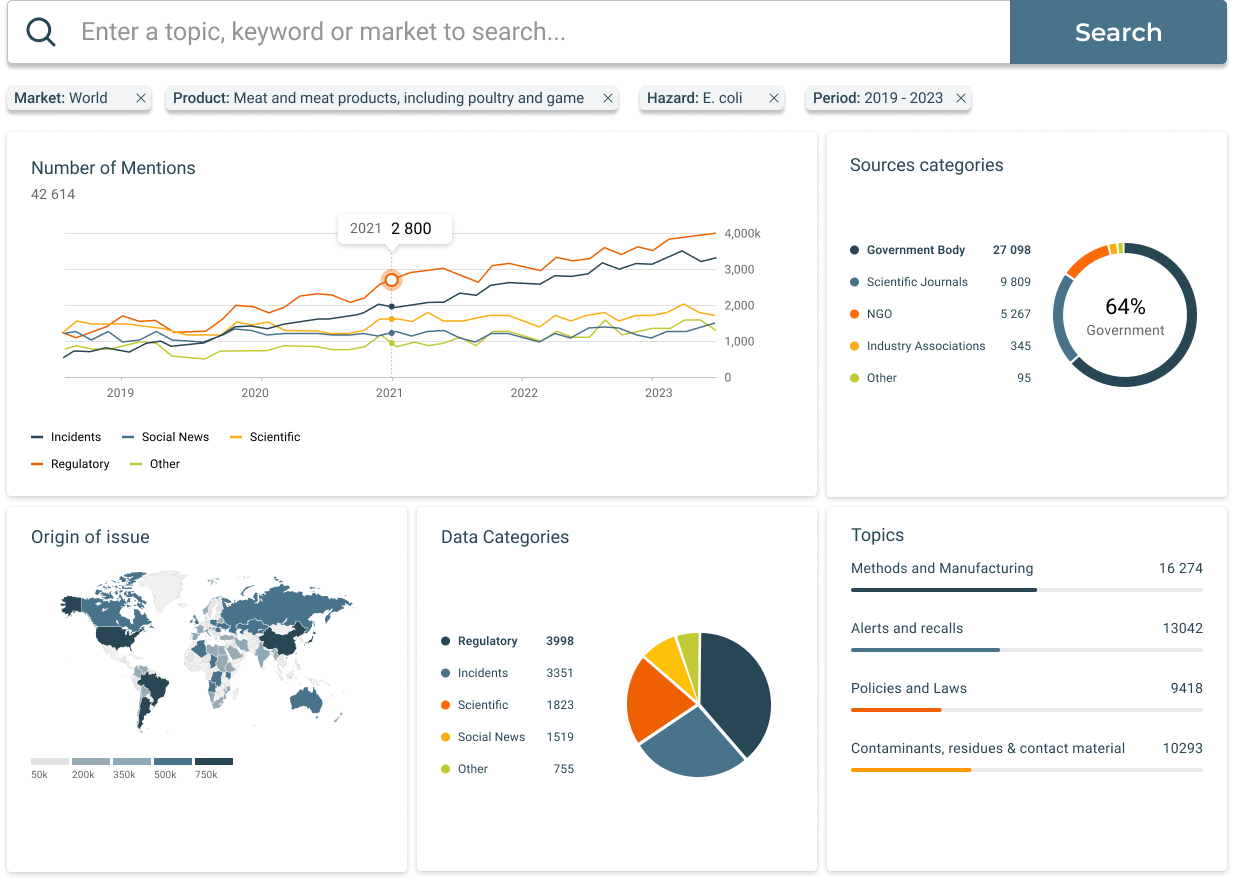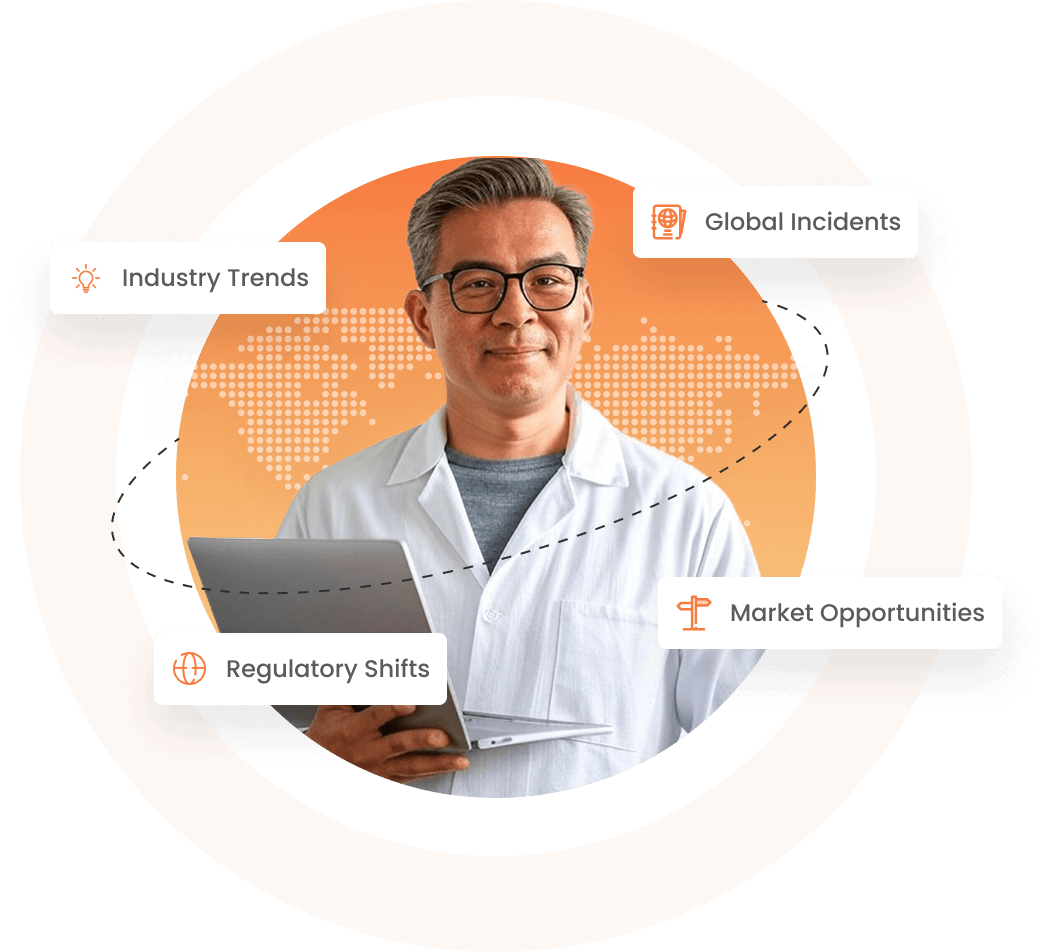TRUSTED BY 50 OF THE TOP 100 GLOBAL FOOD COMPANIES
Uncertainty is a risk. AI turns it into an advantage
Regulatory shifts, supply chain disruptions, and emerging threats can blindside businesses, costing time, money, and market position. Staying ahead isn’t just an advantage—it’s a necessity.
AI-powered Horizon Scanning transforms scattered data into early warnings and strategic foresight, helping you anticipate risks, track regulatory changes, and uncover new opportunities before they impact your business.

Predict risks before they escalate
Stay ahead of regulatory changes, supply chain disruptions, and emerging threats.
Turn unpredictability into opportunity
Gain AI-driven insights to anticipate shifts in the market and make data-backed strategic moves.
Eliminate blind spots in regulatory tracking
Continuously monitor evolving regulations worldwide and adapt before they create compliance risks.
React faster with real-time alerts
Get instant notifications on critical threats and opportunities, allowing for proactive decision-making.
Uncover hidden market opportunities
Spot emerging trends, innovations, and regulatory shifts that open new business possibilities.
Reduce financial and operational risk
Identify and mitigate potential disruptions, contamination threats, and compliance pitfalls.
Simplify complex data into clear insights
AI filters through vast amounts of information, delivering the most relevant and actionable intelligence.
Stay ahead while competitors react
Act on risks and opportunities first to keep your business ahead of the industry.

Melina Dupont
BACARDI
SGS DIGICOMPLY replaced our outdated legacy system with an easy-to-use, efficient platform, allowing us to focus on content and business actions instead of maintaining old infrastructure.
Stay ahead, adapt faster, and seize new opportunities
Horizon Scanning isn’t just about avoiding risks—it’s about identifying opportunities before they emerge. Shifting regulations, evolving technologies, and changing consumer demands create openings for those who can see ahead.
With AI-powered insights, you can spot trends, predict disruptions, and act before the market shifts. Make data-driven decisions with confidence, turning future uncertainty into a competitive advantage.

Stay ahead of change with scanning millions of data sources
AI tracks news, regulations, and scientific research to detect shifts before they impact your business.
Turn data into action with AI-powered insights management
Automatically transform raw information into clear strategies, helping you react faster to risks and opportunities.
Prevent crises with intelligent risk prediction
AI identifies biological, chemical, and reputational hazards early, ensuring proactive decision-making.
Ensure compliance with regulatory foresight
Stay ahead of evolving global regulations and adapt to changes before they create compliance challenges.
Spot opportunities with market insights
Identify trends, innovations, and industry shifts to uncover new business potential before competitors.
Minimize disruptions with food safety risk detection
AI continuously monitors ingredient and supplier risks, helping you avoid costly safety incidents.

Ramona Propson
Ricola
SGS DIGICOMPLY helped us in putting together a Regulatory summary that covered even more countries than we’ve asked for
Ready to stay ahead of risks and opportunities?
Request a demo and see how AI-powered Horizon Scanning helps you track shifts, anticipate risks, and uncover new opportunities.
Frequently asked questions
- What is Horizon Scanning? Horizon Scanning Meaning in the Context of the Food Industry
-
Horizon scanning is the systematic process of identifying, monitoring, and analyzing emerging trends, risks, and opportunities. In the food industry, horizon scanning involves scrutinizing vast datasets from diverse sources to detect biological, chemical, and physical hazards, regulatory changes, and technological advancements. This enables businesses to stay ahead of potential threats and capitalize on new opportunities, ensuring robust food safety and compliance.
- What Are the Key Horizon Scanning Methods?
-
Horizon scanning methods encompass a range of techniques designed to identify, monitor, and analyze emerging trends and potential risks. Here are some of the key methods used in horizon scanning:
- Environmental Scanning: this method involves continuous and systematic monitoring of external sources such as news media, scientific journals, regulatory updates, industry reports, and social media. The goal is to gather information on emerging issues, trends, and events that could impact the organization. Example: A food company might use environmental scanning to track news about food safety incidents worldwide, regulatory changes in different countries, and scientific discoveries related to food contaminants.
- Trend Analysis: trend analysis involves identifying and interpreting patterns or shifts over time from collected data. This method helps in understanding the direction and potential future impact of certain trends. Example: By analyzing trends in consumer behavior, such as the increasing demand for organic products, a company can adjust its product offerings to meet future market demands.
- Scenario Planning: scenario planning is a strategic planning method used to create a set of plausible future scenarios based on current trends and potential developments. It helps organizations anticipate and prepare for various possible futures. Example: A food manufacturer might develop scenarios for different regulatory environments, such as stricter food safety laws or changes in trade policies, to ensure they are prepared for any regulatory shifts.
- Delphi Technique: the Delphi technique involves gathering insights from a panel of experts through iterative rounds of surveys. The experts provide their opinions on specific issues, and through multiple rounds, a consensus or clearer picture of future developments is achieved. Example: To forecast the impact of new food safety technologies, a company might use the Delphi technique to gather expert opinions on the potential adoption and effectiveness of these technologies over the next decade.
- Cross-Impact Analysis: this method evaluates the interactions between different trends or events to understand how they might influence each other. It helps in identifying complex relationships and potential cascading effects.Example: A cross-impact analysis might examine how climate change and regulatory changes together could affect food production and supply chains.
- SWOT Analysis: SWOT analysis assesses the strengths, weaknesses, opportunities, and threats related to a particular trend or development. It helps organizations understand internal and external factors that could impact their strategic plans. Example: A food company might conduct a SWOT analysis to evaluate the impact of adopting new sustainable packaging technologies, considering internal capabilities and external market conditions.
- Weak Signals Detection: this method focuses on identifying weak signals or early indicators of potential changes. Weak signals are often subtle and not immediately obvious but can precede significant trends or events. Example: By monitoring minor shifts in regulatory discussions or initial scientific findings, a company can detect weak signals of future regulatory changes affecting food additives.
These horizon scanning methods enable organizations to gather comprehensive insights, anticipate future developments, and make informed strategic decisions. By combining these methods, businesses can create a robust horizon scanning framework that addresses a wide range of potential risks and opportunities.
- How Can Horizon Technology Assist with Research, Foresight, and Risk Assessment?
-
Horizon scanning technology leverages advanced tools and methodologies to assist organizations in conducting comprehensive research, foresight, and risk assessment. Here's how it works:
- Advanced Data Collection and Integration: Horizon scanning technology automates the collection of data from a wide range of sources, including scientific publications, regulatory updates, news media, industry reports, and social media. This comprehensive data integration ensures that all relevant information is captured and analyzed.Example: A food company uses horizon scanning tools to gather data on emerging food safety hazards from international regulatory bodies, academic research, and industry news, providing a holistic view of potential risks.
- Intelligent Analytics and Machine Learning: These technologies use machine learning algorithms and advanced analytics to process and analyze large datasets. They identify patterns, trends, and correlations that might not be immediately apparent through manual analysis. Example: Machine learning algorithms can detect early warning signals of foodborne illnesses by analyzing trends in health reports and social media mentions, allowing for proactive risk management.
- Predictive Insights and Foresight: Horizon scanning technology provides predictive insights by forecasting potential future developments and their impacts. This foresight capability helps organizations anticipate and prepare for changes before they occur. Example: Predictive models can forecast the impact of climate change on crop yields, enabling agricultural businesses to develop strategies for mitigating adverse effects and ensuring food security.
- Risk Assessment and Early Warning Systems: By continuously monitoring and analyzing data, horizon scanning tools can identify emerging risks and provide early warnings. This enables businesses to implement preventive measures and reduce the likelihood of crises. Example: An early warning system might alert a company to regulatory changes affecting food labeling requirements, allowing them to adjust their packaging and marketing strategies in advance.
- Customized Alerts and Notifications: Users can set up customized alerts and notifications based on specific criteria, such as changes in regulations, scientific discoveries, or market trends. This ensures that relevant stakeholders are informed promptly. Example: A regulatory affairs team receives real-time notifications about new food safety regulations in key markets, ensuring that the company remains compliant and avoids potential fines.
- Comprehensive Reporting and Visualization: Horizon scanning technology includes tools for generating detailed reports and visualizations. These tools help stakeholders understand complex data and make informed decisions based on clear, actionable insights. Example: Interactive dashboards display real-time data on food safety incidents, regulatory changes, and market trends, providing decision-makers with a comprehensive overview of the current landscape.
- Collaboration and Knowledge Sharing: Horizon scanning platforms facilitate collaboration among teams by providing a centralized repository for data and insights. This promotes knowledge sharing and ensures that all relevant parties are aligned. Example: Different departments within a food company, such as R&D, quality assurance, and regulatory affairs, can access and share insights from the horizon scanning platform, fostering a unified approach to risk management and innovation.
These capabilities of horizon scanning technology enable organizations to conduct thorough research, gain foresight into future developments, and perform effective risk assessments. By leveraging these tools, businesses can stay ahead of emerging threats, capitalize on new opportunities, and maintain a competitive edge in the market.
- What Are Some Examples of Horizon Scanning in Practice?
-
Horizon scanning is utilized in various practical applications within the food industry to enhance risk management and strategic planning. Here are some detailed examples:
- Monitoring Regulatory Changes:
Example: A company uses horizon scanning tools to track global regulations concerning food labeling requirements. By staying informed about new legislation in different countries, the company ensures its products remain compliant, avoiding costly recalls and legal issues. For instance, the recent introduction of front-of-pack (FOP) labeling regulations in the European Union can be monitored and adhered to through timely updates provided by horizon scanning.
- Identifying Emerging Food Safety Hazards:
Example: Horizon scanning can detect potential food safety risks linked to climate change, such as the increased likelihood of mycotoxin contamination in cereals due to rising temperatures and humidity levels. By analyzing scientific research and environmental data, businesses can anticipate these risks and implement preventive measures, such as adjusting supply chains or sourcing ingredients from safer regions.
- Tracking Consumer Trends:
Example: Companies utilize horizon scanning to monitor social media and market reports for shifts in consumer preferences, such as the growing demand for plant-based proteins. This information enables businesses to innovate and adapt their product lines to meet emerging consumer demands, gaining a competitive edge in the market.
- Detecting Supply Chain Disruptions:
Example: By analyzing news sources, trade publications, and social media, horizon scanning can provide early warnings of supply chain disruptions, such as geopolitical tensions affecting ingredient availability or transportation strikes. Businesses can use this information to develop contingency plans, ensuring continuous operations and minimizing the impact of disruptions.
- Anticipating Technological Advances:
Example: Horizon scanning tools help companies stay ahead of technological advancements in food processing and packaging. For example, the development of biodegradable packaging materials can be tracked and adopted early, allowing companies to align with sustainability trends and regulatory requirements for reducing single-use plastics.
- Responding to Public Health Alerts:
Example: During the COVID-19 pandemic, horizon scanning was crucial for monitoring the spread of the virus and its impact on the food supply chain. Companies used horizon scanning to stay informed about lockdown measures, workforce availability, and changes in consumer behavior, enabling them to adjust their operations swiftly and maintain supply chain resilience.
These examples demonstrate how horizon scanning can be applied to various aspects of the food industry, providing critical insights and enabling proactive management of risks and opportunities.
- Monitoring Regulatory Changes:
- How Does Regulatory Horizon Scanning Help Navigate Regulatory Changes?
-
Regulatory horizon scanning involves continuously tracking and analyzing updates in laws and regulations that impact the food industry. This process helps businesses stay compliant by providing real-time information on new and upcoming regulatory requirements. Regulatory horizon scanning tools from SGS Digicomply enable companies to adjust their operations accordingly, avoid compliance breaches, and reduce the risk of legal penalties.
- How Is Horizon Scanning Applied in Agriculture?
-
Agriculture horizon scanning focuses on identifying and monitoring risks and opportunities specific to the agricultural sector. This includes tracking environmental factors like climate change, pest outbreaks, and crop diseases, as well as regulatory changes affecting agricultural practices. By leveraging horizon scanning, agricultural businesses can implement timely interventions, improve crop management, and enhance food safety and sustainability.
- How Much Does SGS Digicomply Horizon Scanning Software Cost?
-
The pricing for SGS Digicomply Horizon Scanning Software is tailored to meet the specific needs and requirements of your company. To ensure that you receive a solution that fits your unique operational needs, features and pricing are customized for each company's situation. For detailed pricing information specifically tailored to your company, you can request a quote by filling out the form on this page. This process will enable us to provide a proposal that best suits your needs and ensures you receive the most appropriate solution.
- What are the key features of the software for risk management?
-
The software features sophisticated risk assessment tools that leverage AI to forecast potential food safety issues and provide actionable insights. This proactive approach allows for timely interventions and helps prevent food safety incidents.
- How does the platform facilitate food safety audits and reporting?
-
The platform streamlines the food safety audit process by providing tools for comprehensive data collection and analysis, which supports the execution of audits and generation of detailed compliance reports. These features aid businesses in demonstrating their adherence to food safety regulations and making informed management decisions.
Read our guide: What is a Food Safety Audit: How to Prepare, Software, Checklist. - How much does SGS Digicomply Food Safety Software cost?
-
The pricing for SGS Digicomply Food Safety Software is tailored to meet the specific needs and requirements of your company. To ensure that you receive a solution that fits your unique operational needs, features and pricing are customized for each company's situation. For detailed pricing information that is specifically tailored to your company, you can request a quote by filling out the form on this page. This process will enable us to provide a proposal that best suits your needs and ensures you receive the most appropriate solution.





.png?width=400&height=260&name=Insights%20Flow%20(1).png)